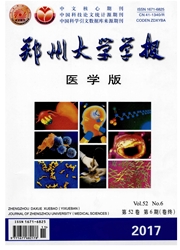

 中文摘要:
中文摘要:
目的:应用人工神经网络( ANN)技术联合肿瘤标志蛋白芯片建立人工智能辅助诊断模型,探讨其对肺癌诊断的价值。方法:采用蛋白芯片(化学发光法)测定201例肺良性疾病患者、202例肺癌患者血清中9项血清肿瘤标志( CA199、Ferritin、AFP、CA153、CEA、NSE、CA242、CA125、HGH)的水平,logistic回归筛选,建立ANN和Fisher判别分析肺癌诊断模型。结果:4项肿瘤标志( CEA、NSE、Ferritin、CA153)建立的ANN模型的ROC曲线下面积(0.850)高于4项 Fisher、6项(CEA、NSE、Ferritin、CA153、AFP、CA125) Fisher 和6项 ANN的ROC 曲线下面积(0.793、0.767和0.825)。结论:基于4种肿瘤标志的ANN模型判别诊断肺癌的效果优于Fisher判别分析,优于6种肿瘤标志建立的ANN模型;ANN模型诊断效果优于Fisher判别分析。
 英文摘要:
英文摘要:
Aim:To establish the model by artificial neural network ( ANN ) technology combined with tumor marker protein chip for the diagnosis of lung cancer ,and to explore the diagnosis value of artificial intelligence model .Methods:Protein chips based on chemiluminescence were used to measure the levels of nine serum tumor markers (CA199,Ferritin, AFP,CA153,CEA,NSE,CA242,CA125,HGH) in 201 cases of benign lung diseases and 203 cases of lung cancer.Multi-variate logistic regression was employed to optimize the tumor marker group .ANN and Fisher discriminant analysis was used to develop the two diagnostic model of lung cancer .Results:Based on the optimal four tumor markers ( CEA,NSE,Ferritin, CA153),area under the ROC curve of ANN model (0.850) was higher than those of the Fisher discriminant analysis based on the optimal four and six tumor markers (CEA,NSE,Ferritin,CA153,AFP,CA125) as well as ANN model based on the optimal six tumor markers(0.793,0.767 and 0.825).Conclusion:Based on the four kinds of tumor markers in the diagno-sis of lung cancer ,ANN model is better than Fisher discriminant analysis .ANN model established by six tumor markers is superior to Fisher discriminant analysis .
 同期刊论文项目
同期刊论文项目
 同项目期刊论文
同项目期刊论文
 期刊信息
期刊信息
